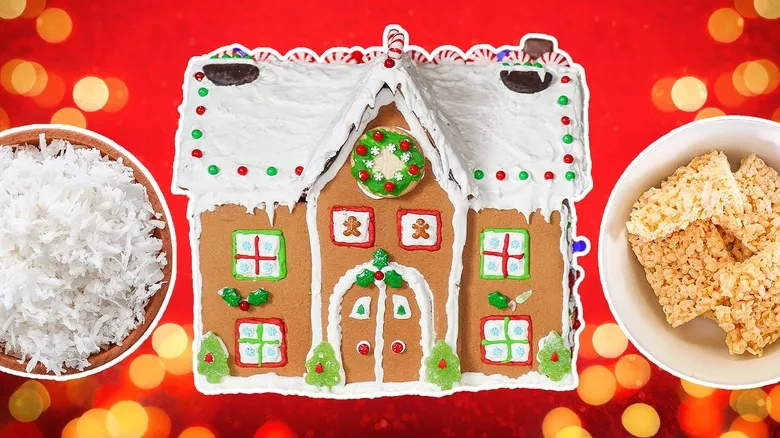Bake your gingerbread properly

Before you begin constructing a gingerbread house, it's essential to have reliable building materials. Properly preparing the dough lays the foundation for a sturdy house and helps prevent structural issues later on. Chef Flora Aghababyan, Chief Cake Designer at the Wynn Las Vegas, shared some of her insights for improving your gingerbread baking. "Make sure to measure your ingredients accurately," Aghababyan recommends. "Weighing them can help ensure that the gingerbread house has a consistent structure and reduces the risk of it collapsing."
Once you've combined all the ingredients, "ensure the dough is thoroughly mixed without any dry patches. The texture should be firm and slightly sticky." It's important to avoid significant air bubbles that could lead to weak areas after baking. After preparing the dough, allow it to rest before rolling, shaping, or baking.
Freeze the dough before baking to minimize spread
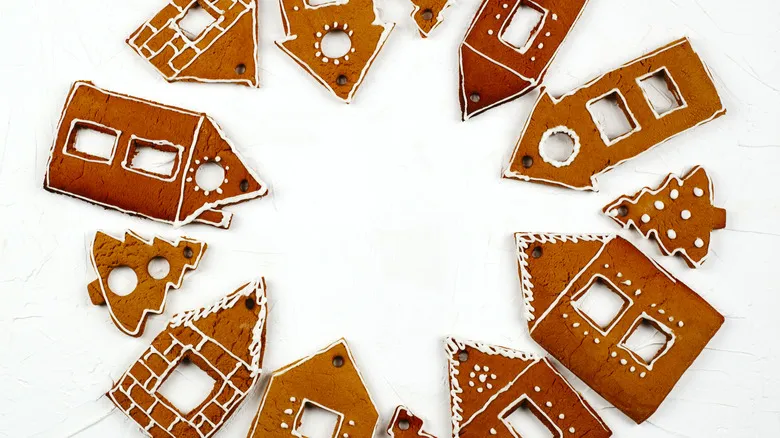
Cookie spread can pose a significant challenge when constructing gingerbread houses. After all the effort of rolling and cutting your gingerbread pieces to match your grand design, the last thing you want is for the dough to spread unevenly and create complications.
Doug Orr, the Executive Pastry Chef and Gingerbread Architect at Amway Grand Plaza, recommends, "Refrigerate or freeze your gingerbread dough before cutting it to the desired size. Chilled dough is much easier to work with." Once the dough has cooled in the freezer, it's the ideal moment to cut the pieces to the correct shape and size. To ensure accuracy, it's important to approach this step with intention. "Always begin with a sturdy template, such as a cardboard model," Orr advised. "Secure the cardboard pieces together with tape to ensure a precise and stable fit."
Bake the cookie low and slow
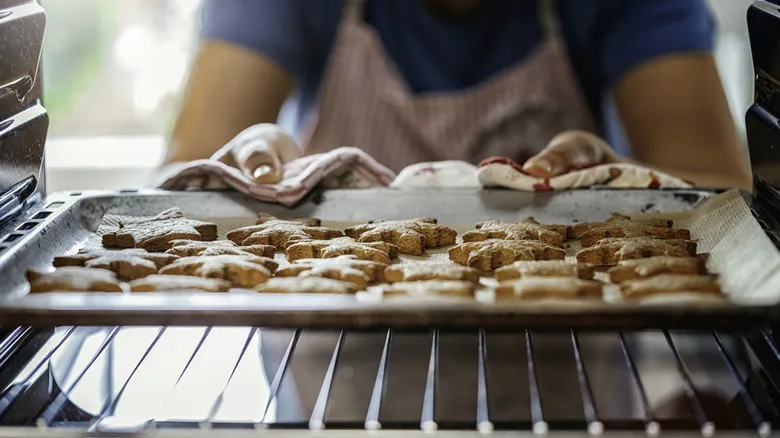
Do you believe that a hot oven is the key to the perfect gingerbread house? Think again. The temperature of your oven can significantly impact your cookies, and as Doug Orr points out, the goal is to dry out the cookie dough to achieve a crisp, sturdy texture that can support its own weight without bending or breaking. "Bake the gingerbread at a lower temperature for a longer duration than usual," advises Orr. This method will help to dry it out just enough to ensure it’s robust enough for both assembly and decoration.
The ideal temperature is below 350°F (Flora Aghababyan suggests 320°F), as this lower heat allows the dough to bake evenly, avoiding any soft spots that could compromise its structure. Before placing the dough on a baking sheet, consider adding an extra layer of protection. Using parchment paper or silicone mats during baking will prevent the gingerbread from sticking, helping to maintain its clean edges. Allow the pieces to cool completely before assembling them to preserve their shape and integrity. You can also leave the pieces in the oven after turning it off to cool down, which will help them dry out even further.
Perfect your royal icing
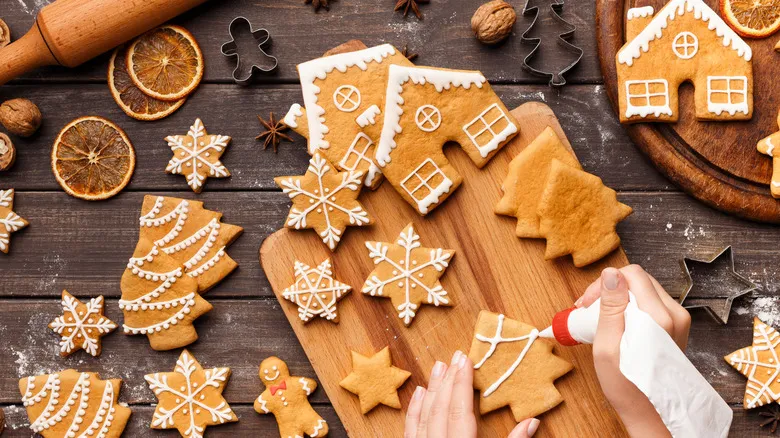
When constructing a gingerbread house, selecting the right frosting is crucial to the success of the project. As Doug Orr points out, "A well-prepared royal icing serves as the ideal adhesive." Achieving the correct texture and consistency can determine the fate of your gingerbread creation; Flora Aghababyan suggests using "a thick royal icing to ensure all components adhere properly."
Royal icing is a straightforward blend of powdered sugar and egg white or powdered meringue. Orr's recipe calls for three ounces of egg whites for every pound of powdered sugar, along with 1½ tablespoons of cream of tartar. You can easily modify the consistency to meet your requirements by adding more sugar or thinning it with a small amount of water. It's essential to store your royal icing properly to prevent it from drying out. Orr also advises that you can "re-whip the icing every 20 minutes to introduce air and maintain its fluffiness."
Use hot glue as your secret weapon
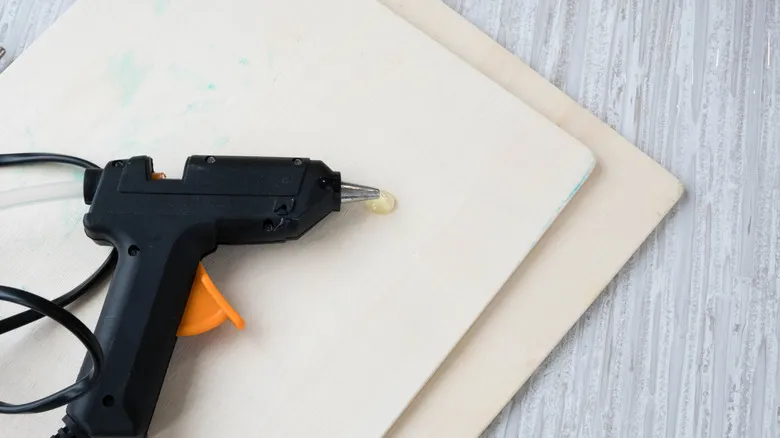
If you're open to a bit of help while building your gingerbread house (we won't call it cheating), a hot glue gun can be incredibly useful. After decorating and allowing the walls and roof pieces to dry, you can secure them together with thick lines of hot glue. This technique is effective for assembling the pieces since it's easy to use and dries rapidly.
Keep in mind that this approach renders the house inedible, but most people aren't likely to munch on their gingerbread creations anyway. If you prefer, you can use hot glue solely for securing the walls and roof, while relying on royal icing for all the decorative elements and candy attachments. Additionally, if you need some extra support while the walls dry, a few cans from your pantry can serve as temporary support columns.
Mist the dough before sprinkling with crystal sugar

Another wonderfully straightforward (yet not overly obvious) suggestion from Doug Orr is to lightly mist your materials with water before beginning your construction. "Gently spray the gingerbread with water and evenly sprinkle a layer of crystal or granulated sugar on top," he advises. "This creates a textured surface, allowing the royal icing to adhere more effectively than it would on a smooth one." This tip is simple but incredibly effective. Additionally, the sugar adds the delightful appearance of ice crystals or a fresh layer of Christmas snow to your gingerbread pieces.
If you don’t have sanding or crystal sugar available but still want to add some texture to your cookies, consider using a microplane to scrape the sides or edges. This will create a slightly rough surface, making it easier for the royal icing to stick and providing a stronger bond at the joints.
Give the house crystal clear window panes
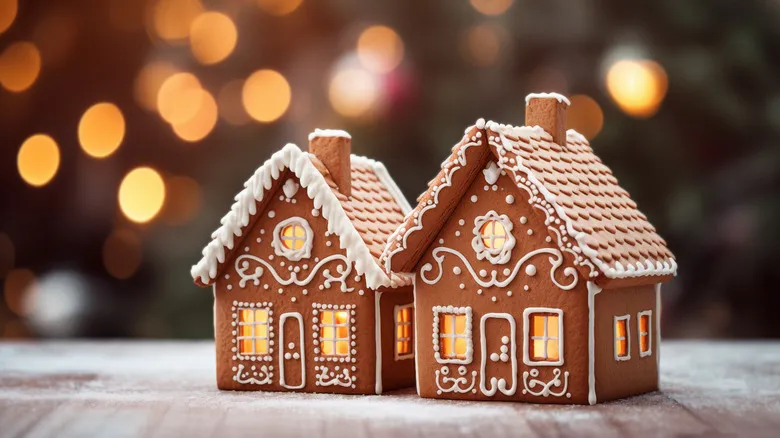
Crafting lifelike windows for your gingerbread house can enhance its festive and authentic appearance. One effective method is to use crushed Jolly Ranchers to create vibrant, stained-glass windowpanes. Simply fill the window cutouts of your gingerbread with the crushed candy before baking; the heat will melt the pieces into a smooth, shiny finish that solidifies as it cools.
For a transparent, frosted-glass look without baking, gelatin sheets can be a great alternative, and PerfectaGel Gold Gelatin Sheets are a fantastic option. Cut the gelatin to fit the window openings and secure it with royal icing after baking. This technique produces a delicate, frosty effect, perfect for a winter theme. Both methods are edible, versatile, and add a delightful, professional flair to your gingerbread house. Before sealing up the house, consider placing a string of remote-controlled fairy lights inside to create a warm, festive glow.
Decorate the walls and roofs before assembling them
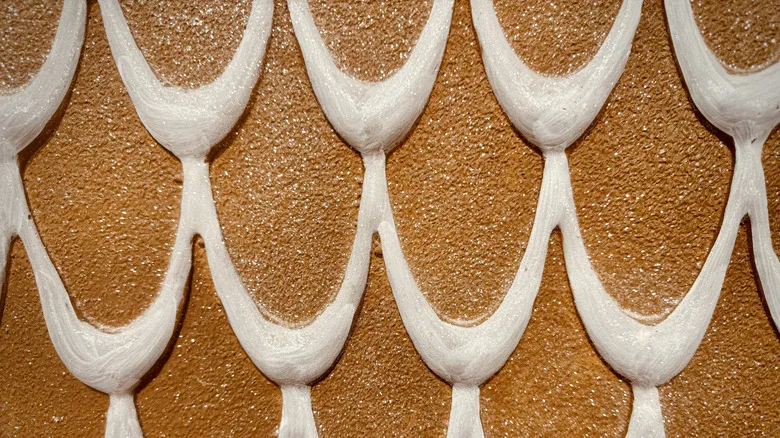
When building a gingerbread house, it's important to avoid battling gravity. For optimal results, always decorate the walls and roof pieces prior to assembling the structure. This technique allows for easier application of intricate designs, piping, and details without the concern of stability or awkward angles. It can be helpful to place the flat pieces on a solid surface and secure them with a bit of tape or a non-slip mat to keep them steady while you work.
Once the decorations are finished and the icing has fully dried, putting the house together becomes effortless. This approach not only results in cleaner lines and fewer smudges but also minimizes the risk of damaging the structure during the decorating phase. You can always add more decorations and candies later if you wish to enhance its appearance, providing you with greater flexibility to improve its design than if you were to decorate it after assembly.
Dessicated coconut makes for the best fake snow
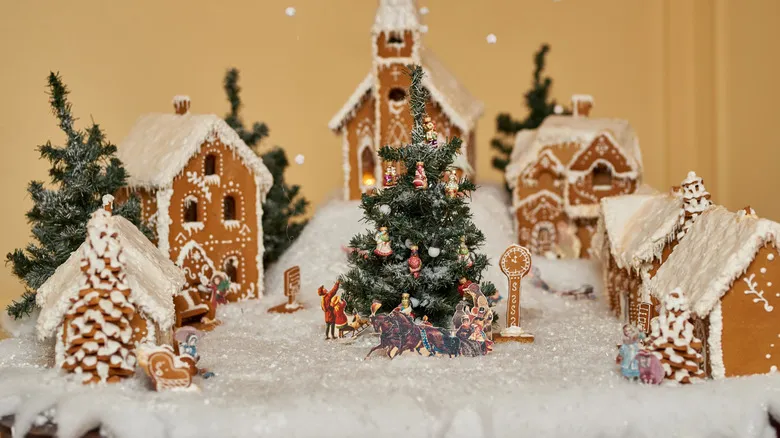
When it comes to crafting a picture-perfect gingerbread house, the snowy backdrop is just as crucial as the house itself. For a realistic and charming effect, desiccated coconut is the ideal choice for faux snow. Unlike powdered sugar, which can absorb moisture and become clumpy over time, desiccated coconut maintains its fluffy texture and pristine look, making it perfect for decoration. In addition to its fine, powdery consistency, it also boasts a subtle natural sheen that adds a hint of sparkle.
To implement this tip, simply sprinkle the coconut over a layer of royal icing or melted white chocolate to keep it in place. You can also use it to create snowdrifts along the edges of your gingerbread house or as a final touch on the roof. Unsure where to begin? Position your completed gingerbread houses on a rimmed baking sheet, then fill in the coconut "snow" around them.
Make your own custom candy decorations
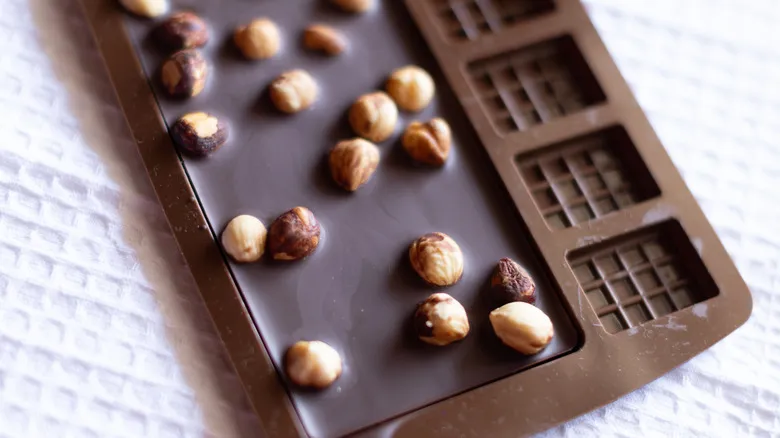
Flora Aghababyan suggests that the secret to an extraordinary gingerbread house lies in its decoration. A fun way to spark conversations with friends and family is by crafting your own candies to embellish your gingerbread creation. As Aghababyan puts it, "What could be more surprising than making your own candies?" Homemade treats offer a unique opportunity to add design elements to your gingerbread house that are truly one-of-a-kind.
Creating handmade gingerbread houses is all about pushing your limits as a baker, making it an excellent opportunity to broaden your skills. With a touch of creativity, dark chocolate salted caramel squares can transform into charming stepping stones, while Christmas wreaths crafted from cornflakes can beautifully decorate every window and door. Even simple melted chocolate poured into molds with crushed nuts can be reimagined as a rock-clad fireplace or a rustic garden wall.
Recommended
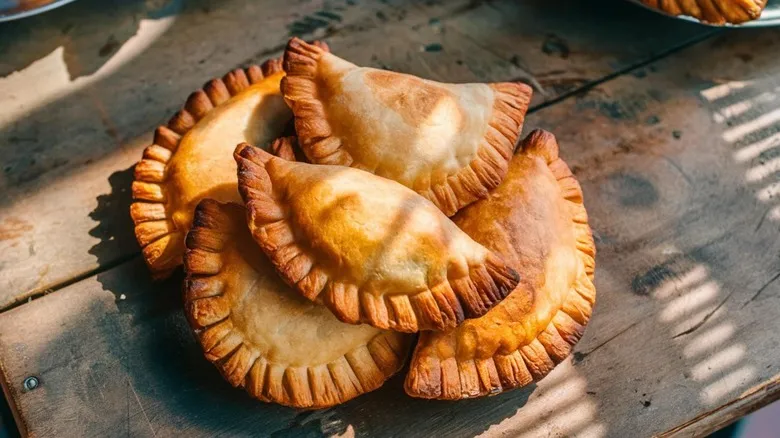
The Expert Advice You Need To Make Perfect Empanada Dough
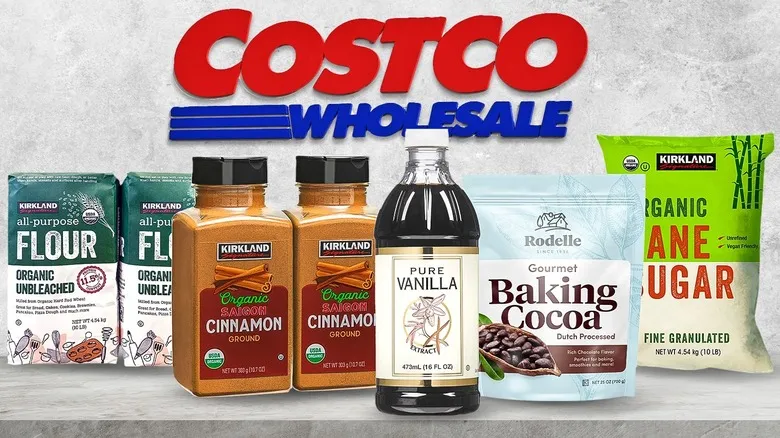
13 Baking Staples To Stock Up On At Costco
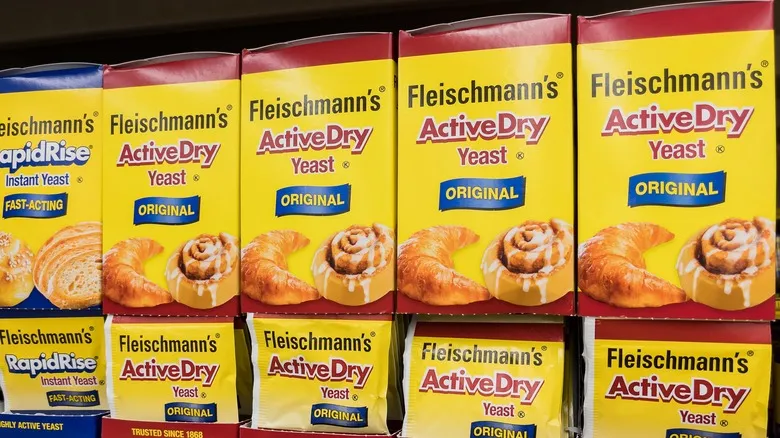
What Does It Mean To Proof Yeast?

Why Carla Hall Believes Cake Batter Should Be Lumpy
Next up

